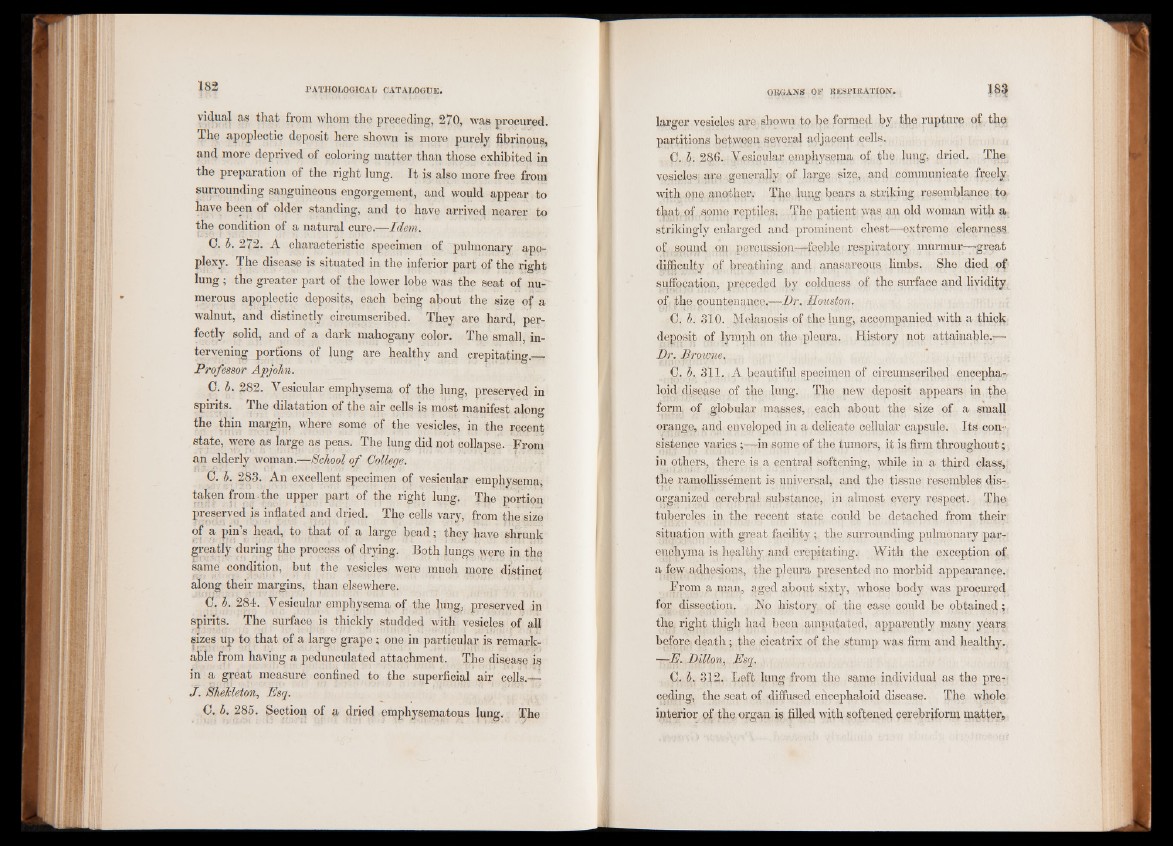
vidua] as that from whom the preceding, 270, was procured.
The apoplectic deposit here shown is more purely fibrinous,
and more deprived of coloring matter than those exhibited in
the preparation of the right lung. It is also more free from
surrounding sanguineous engorgement, and would appear to
have been of older standing, and to have arrived nearer to
the condition of a natural cure.—Idem.
C. b. 272. A characteristic specimen of pulmonary apoplexy.
The disease is situated in the inferior part of the right
lung ; the greater part of the lower lobe was the seat of numerous
apoplectic deposits, each being about the size of a
walnut, and distinctly circumscribed. They are hard, perfectly
solid, and of a dark mahogany color. The small, intervening
portions of lung are healthy and crepitating.__
Professor Apjohn.
0. b. 282. Vesicular emphysema of the lung, preserved in
spirits. The dilatation of the air cells is most manifest along
the thin margin, where some of the vesicles, in the recent
state, were as large as peas. The lung did not collapse- From
an elderly woman.—School of College.
0. b. 283. An excellent specimen of vesicular emphysema,
taken from , the upper part of the right lung. The portion
preserved is inflated and dried. The cells vary, from the size
of a pin’s head, to that of a large bead; they have shrunk
greatly during the process of drying. Both lungs \yere in the
same condition, but the vesicles were much niore distinct
along their margins, than elsewhere.
C. b. 284. Vesicular emphysema of the lung, preserved in
spirits. The surface is thickly studded with vesicles of all
sizes up to that of a large grape; one in particular is remarkable
from having a pedunculated attachment. The disease is
in a great measure confined to the superficial air cells.—
J. SheJcleton, Esq.
C. b. 285. Section of a dried emphysematous lung. The
larger vesicles are shown to be formed by the rupture of the
partitions between several adjacent cells.
C. 5. 286. Vesicular emphysema of the lung, dried. The
vesicles; afe generally of large size, and communicate freely,
with one another. The lung bears a striking resemblance tq>.-
tfiat of gome reptileg.. Thp patient was an old woman with a
strikingly enlarged and prominent chest—extreme clearness,
of, sound on pemission-^feeblo respiratory murmur—great
difficulty of breathing and anasarcous limbs. She died of
suffocation, preceded by coldness of the surface and lividity
of( thp,countenance.—Dr, Houston. .
0. b. 310. Melanosis of the lung, accompanied with a thick
deposit of lymph on the pleura. History not attainable.—
Dr. Browyie.
0. b. 311. A beautiful specimen of circumscribed encepha--
loid disease of the lung. The new deposit appears in the.
form of globular masses, each about the size of a small
orange? and enveloped in a delicate cellular capsule. Its consistence
varies ;-rrin some of the tumors, it is firm throughout;
in others, there is, a central softening, while in a third class,
the ramollissement is universal, and the tissue resembles disorganized
cerebral substance, in almost every respect. The
tubercles in the recent state could be detached from their
situation with great facility; the, surrounding pulmonary parenchyma
is healthy and crepitating. With the exception of
a few adhesions, the pleura presented no morbid appearance.
From a man, aged about sixty, whose body was procured
for dissection. No history of the case could be obtained;
the right thigh had been amputated, apparently many years
before, death; the cicatrix of the stump was firm and healthy.
-r-E. Dillon, Esq, .
Q. b. 3 12 , Left lung from the same individual as the preceding,
the seat of diffused ehcephaloid disease. The whole
interior of the organ is filled with softened cerebriform matter,